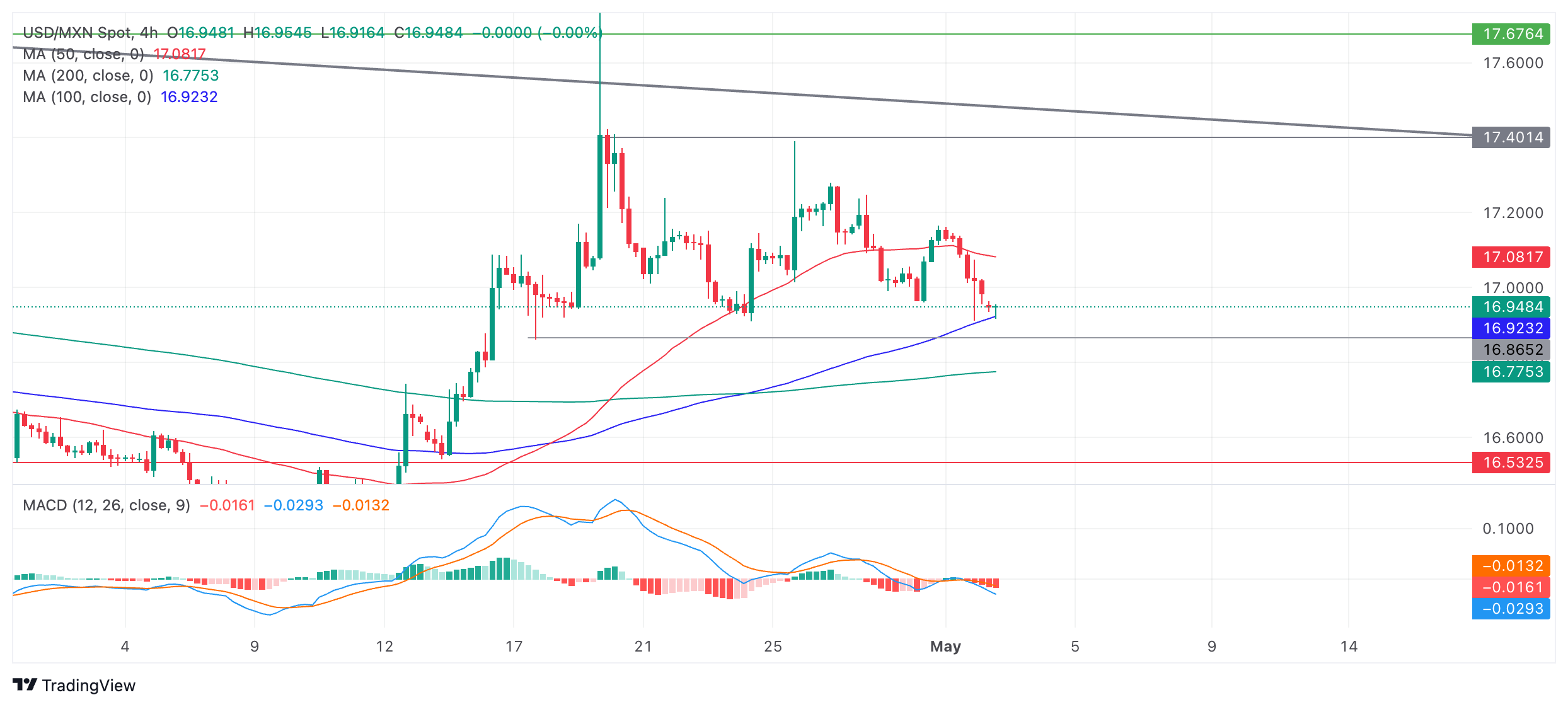- The Mexican Peso rises as market sentiment lifts following the Federal Reserve meeting on Wednesday.
- Despite acknowledging inflation remained sticky, the Fed’s Chair Jerome Powell described the need for higher interest rates as “unlikely”.
- The Fed’s decision to reduce its Treasury holdings at a slower pace was taken by markets as a mildly dovish move, possibly weakening the USD.
The Mexican Peso (MXN) trades higher in its key pairs on Thursday as market sentiment gets a lift from a combination of factors, including the US Federal Reserve’s (Fed) decision to maintain an easing bias at its policy meeting on Wednesday, and Crude Oil prices hovering close to seven-week lows.
Mexican Business Confidence falls slightly to 54.2 in April from an upwardly revised 54.4 in March, according to data from INEGI released on Thursday. The metric remains at high levels historically, however, and does not prevent the Mexican Peso from trending higher.
USD/MXN is trading at 16.92, EUR/MXN at 18.11 and GBP/MXN at 21.20 during the US session.
Mexican Peso gains on positive market sentiment
The Mexican Peso, which is sensitive to risk trends, is seeing gains across the board as market sentiment stays positive on Thursday. The Federal Reserve’s decision to keep interest rates at their current level despite persistently firm inflation in the US; the fact that Federal Reserve Chairman Jerome Powell considered a further rise in borrowing costs as “unlikely”, and the Fed’s decision to reduce its holdings of US Treasuries at a slower pace – a dovish move – were all factors supporting a positive outlook for markets.
Lower Crude Oil prices, with WTI trading in the mid $79s, were a further positive factor for global risk sentiment as they reduce companies’ transportation and energy costs.
Asian stocks markets traded mixed overnight, with the Nikkei closing down 0.19%, the Shanghai Composite Index closing down 0.26% but Hong Kong’s Hang Seng up by 2.44% and India’s Sensex 0.36% higher, at the time of writing.
Mexican Peso traders now await S&P Global Mexican Manufacturing PMI data for April out at 15:00 GMT for further clues about how well the sector is bearing up under Banxico's restrictive interest-rate regime.
In March, Mexico’s Manufacturing PMI eased down to 52.2 from 52.3 in February but remained in expansive territory (above 50), as it has done since September 2023.
A substantial decline in the metric could increase the chances of the Banxico reducing interest rates more rapidly than previously expected. This in turn would probably lead to a depreciation of the Mexican Peso, since lower interest rates reduce capital inflows. The opposite would be the case for a substantial rise in the PMI.
Business Confidence for Mexico is also scheduled for release at 12:00 GMT on Thursday. Previously, the metric stood at 54.3.
Technical Analysis: USD/MXN in sideways short-term trend
USD/MXN extends its short-term sideways trend, oscillating between the parameters of a range with a floor at 16.86 and a ceiling at 17.40.
USD/MXN 4-hour Chart
The pair is currently trading close to the range lows.
Given the sideways trend is biased to continue, the next move will probably be an up leg back towards the range highs, however, there are no signs as yet of such a move evolving.
A decisive breakout of the range – either below the floor at 16.86, or the ceiling at 17.40 – would change the directional bias of the pair.
A break below the floor could see further downside to a target at 16.50, followed by the April 9 low at 16.26.
On the other side, a break above the top would activate an upside target first at 17.67, piercing a long-term trendline and then possibly reaching a further target at around 18.15.
A decisive break would be one characterized by a longer-than-average green or red daily candlestick that pierces above or below the range high or low, and that closes near its high or low for the period; or three green/red candlesticks in a row that pierce above/below the respective levels.
Banxico FAQs
The Bank of Mexico, also known as Banxico, is the country’s central bank. Its mission is to preserve the value of Mexico’s currency, the Mexican Peso (MXN), and to set the monetary policy. To this end, its main objective is to maintain low and stable inflation within target levels – at or close to its target of 3%, the midpoint in a tolerance band of between 2% and 4%.
The main tool of the Banxico to guide monetary policy is by setting interest rates. When inflation is above target, the bank will attempt to tame it by raising rates, making it more expensive for households and businesses to borrow money and thus cooling the economy. Higher interest rates are generally positive for the Mexican Peso (MXN) as they lead to higher yields, making the country a more attractive place for investors. On the contrary, lower interest rates tend to weaken MXN. The rate differential with the USD, or how the Banxico is expected to set interest rates compared with the US Federal Reserve (Fed), is a key factor.
Banxico meets eight times a year, and its monetary policy is greatly influenced by decisions of the US Federal Reserve (Fed). Therefore, the central bank’s decision-making committee usually gathers a week after the Fed. In doing so, Banxico reacts and sometimes anticipates monetary policy measures set by the Federal Reserve. For example, after the Covid-19 pandemic, before the Fed raised rates, Banxico did it first in an attempt to diminish the chances of a substantial depreciation of the Mexican Peso (MXN) and to prevent capital outflows that could destabilize the country.
Information on these pages contains forward-looking statements that involve risks and uncertainties. Markets and instruments profiled on this page are for informational purposes only and should not in any way come across as a recommendation to buy or sell in these assets. You should do your own thorough research before making any investment decisions. FXStreet does not in any way guarantee that this information is free from mistakes, errors, or material misstatements. It also does not guarantee that this information is of a timely nature. Investing in Open Markets involves a great deal of risk, including the loss of all or a portion of your investment, as well as emotional distress. All risks, losses and costs associated with investing, including total loss of principal, are your responsibility. The views and opinions expressed in this article are those of the authors and do not necessarily reflect the official policy or position of FXStreet nor its advertisers. The author will not be held responsible for information that is found at the end of links posted on this page.
If not otherwise explicitly mentioned in the body of the article, at the time of writing, the author has no position in any stock mentioned in this article and no business relationship with any company mentioned. The author has not received compensation for writing this article, other than from FXStreet.
FXStreet and the author do not provide personalized recommendations. The author makes no representations as to the accuracy, completeness, or suitability of this information. FXStreet and the author will not be liable for any errors, omissions or any losses, injuries or damages arising from this information and its display or use. Errors and omissions excepted.
The author and FXStreet are not registered investment advisors and nothing in this article is intended to be investment advice.
Recommended content
Editors’ Picks

EUR/USD drops to two-year lows below 1.0400 after weak PMI data
EUR/USD stays under bearish pressure and trades at its weakest level in nearly two years below 1.0400. The data from Germany and the Eurozone showed that the business activity in the private sector contracted in early November, weighing on the Euro.

GBP/USD falls to six-month lows below 1.2550, eyes on US PMI
GBP/USD extends its losses for the third successive session and trades at a fresh fix-month low below 1.2550 on Friday. Disappointing PMI data from the UK weigh on Pound Sterling as market focus shift to US PMI data releases.

Gold price refreshes two-week high, looks to build on momentum beyond $2,700 mark
Gold price hits a fresh two-week top during the first half of the European session on Friday, with bulls now looking to build on the momentum further beyond the $2,700 mark. This marks the fifth successive day of a positive move and is fueled by the global flight to safety amid persistent geopolitical tensions stemming from the intensifying Russia-Ukraine war.

Ripple surges to a new yearly high; XRP bulls aim for three-year high of $1.96
Ripple extends its gains by around 10% on Friday, reaching a new year-to-date high of $1.43 and hitting levels not seen since mid-May 2021. The main reasons behind the rally are the announcement that the US SEC's Chair Gary Gensler will resign and the launch in Europe of an XRP ETP by asset management company WisdomTree.

A new horizon: The economic outlook in a new leadership and policy era
The economic aftershocks of the COVID pandemic, which have dominated the economic landscape over the past few years, are steadily dissipating. These pandemic-induced economic effects are set to be largely supplanted by economic policy changes that are on the horizon in the United States.

Best Forex Brokers with Low Spreads
VERIFIED Low spreads are crucial for reducing trading costs. Explore top Forex brokers offering competitive spreads and high leverage. Compare options for EUR/USD, GBP/USD, USD/JPY, and Gold.
